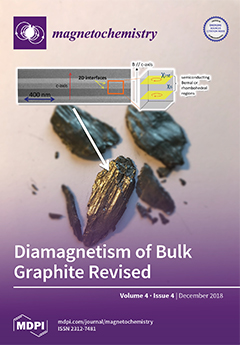The reactions of hydrated lanthanide(III) [Ln(III)] nitrates and salicylideneaniline (salanH) have provided access to two families of mononuclear complexes depending on the reaction solvent used. In MeCN, the products are [Ln(NO
3)
3(salanH)
2(H
2O)]·MeCN, and, in MeOH, the products are [Ln(NO
3)
3(salanH)
2(MeOH)]·(salanH). The complexes within each family are proven to be isomorphous. The structures of complexes [Ln(NO
3)
3(salanH)
2(H
2O)]·MeCN (Ln = Eu,
4·MeCN_Eu, Ln = Dy,
7·MeCN_Dy; Ln = Yb,
10·MeCN_Yb) and [Ln(NO
3)
3(salanH)
2(MeOH)]·(salanH) (Ln = Tb,
17_Tb; Ln = Dy,
18_Dy) have been solved by single-crystal X-ray crystallography. In the five complexes, the Ln
III center is bound to six oxygen atoms from the three bidentate chelating nitrato groups, two oxygen atoms from the two monodentate zwitterionic salanH ligands, and one oxygen atom from the coordinated H
2O or MeOH group. The salanH ligands are mutually “
cis” in
4·MeCN_Eu,
7·MeCN_Dy and
10·MeCN_Yb while they are “
trans” in
17_Tb and
18_Dy. The lattice salanH molecule in
17_Tb and
18_Dy is also in its zwitterionic form with the acidic H atom being clearly located on the imine nitrogen atom. The coordination polyhedra defined by the nine oxygen donor atoms can be described as spherical tricapped trigonal prisms in
4·MeCN_Eu,
7·MeCN_Dy, and
10·MeCN_Yb and as spherical capped square antiprisms in
17_Tb and
18_Dy. Various intermolecular interactions build the crystal structures, which are completely different in the members of the two families. Solid-state IR data of the complexes are discussed in terms of their structural features.
1H NMR data for the diamagnetic Y(III) complexes provide strong evidence that the compounds decompose in DMSO by releasing the coordinated salanH ligands. The solid complexes emit green light upon excitation at 360 nm (room temperature) or 405 nm (room temperature). The emission is ligand-based. The solid Pr(III), Nd(III), Sm(III), Er(III), and Yb(III) complexes of both families exhibit Ln
III-centered emission in the near-IR region of the electromagnetic spectrum, but there is probably no efficient salanH→Ln
III energy transfer responsible for this emission. Detailed magnetic studies reveal that complexes
7·MeCN_Dy,
17_Tb and
18_Dy show field-induced slow magnetic relaxation while complex [Tb(NO
3)
3(salanH)
2(H
2O)]·MeCN (
6·MeCN_Tb) does not display such properties. The values of the effective energy barrier for magnetization reversal are 13.1 cm
−1 for
7·MeCN_Dy, 14.8 cm
−1 for
17_Tb, and 31.0 cm
−1 for
18_Dy. The enhanced/improved properties of
17_Tb and
18_Dy, compared to those of
6_Tb and
7_Dy, have been correlated with the different supramolecular structural features of the two families. The molecules [Ln(NO
3)
3(salanH)
2(MeOH)] of complexes
17_Tb and
18_Dy are by far better isolated (allowing for better slow magnetic relaxation properties) than the molecules [Ln(NO
3)
3(salanH)
2(H
2O)] in
6·MeCN_Tb and
7·MeCN_Dy. The perspectives of the present initial studies in the Ln(III)/salanH chemistry are discussed.
Full article





